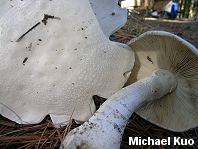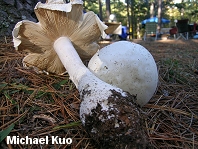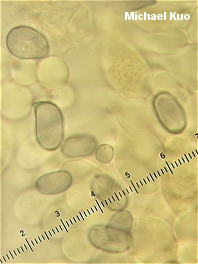| Major Groups > Gilled Mushrooms > Pale-Spored > Amanita > Amanita polypyramis |

|
Amanita polypyramis [ Basidiomycetes > Agaricales > Amanitaceae > Amanita . . . ] by Michael Kuo Amanita polypyramis is a large Amanita from the notoriously difficult section Lepidella--but a combination of features makes it fairly distinct among similar species:
Amanita polypyramis appears in the United States from Texas to New Jersey and Florida, and southward through Mexico to Central America. Because of its odor, which is foul and reminiscent of chlorine, it is often labeled "Amanita chlorinosma," but that species is somewhat smaller and features a less distinct basal bulb. Description: Ecology: Mycorrhizal with oaks; often found in pine-oak forests; usually growing alone or scattered; summer and fall; distributed from New Jersey to Florida, Texas, and Costa Rica. Cap: 7-21 cm; convex, becoming broadly convex or nearly flat; moist or dry; covered with a powdery layer that soon becomes aggregated into soft warts or patches; whitish; the margin not lined, but often hung with veil material. Gills: Free from the stem or nearly so; creamy or dirty buff; close or crowded; short-gills frequent. Stem: 7-20 cm long; up to 3.5 cm thick; tapering slightly to the apex; colored like the cap and similarly covered with powdery material, at least when young; with a large, skirtlike, fragile, whitish ring that often disappears; terminating in an abrupt, more or less round, basal bulb; with powdery, indistinct universal veil remnants. Flesh: White; unchanging when sliced. Spore Print: White. Microscopic Features: Spores 9-14 x 5-10 µ; smooth; broadly ellipsoid; amyloid. Basidia 4-spored; lacking basal clamps. Pileipellis a cutis or ixocutis of hyphae 3-7 µ wide. Lamellar trama bilateral; subhymenium with inflated elements. REFERENCES: (Berkeley & M. A. Curtis, 1853) Saccardo, 1887. (Weber & Smith, 1985; Jenkins, 1986; Metzler & Metzler, 1992; Miller & Miller, 2006; Binion et al., 2008; Tulloss, 2013.) Herb. EIU ASM 10,041. This site contains no information about the edibility or toxicity of mushrooms. |
© MushroomExpert.Com |
|
Cite this page as: Kuo, M. (2013, May). Amanita polypyramis. Retrieved from the MushroomExpert.Com Web site: http://www.mushroomexpert.com/amanita_polypyramis.html |


